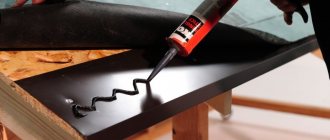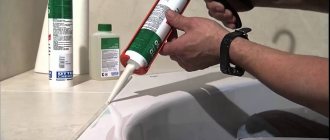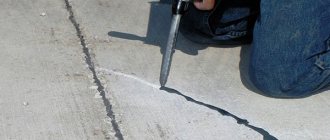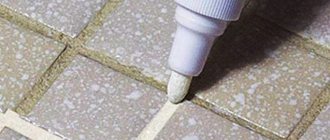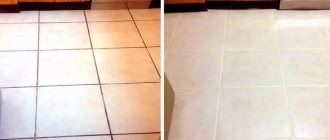If nothing is done about this, then drafts will appear in the house, and over time, mold will appear, which will lead to rotting of the logs.
Until recently, this problem could be dealt with by caulking a log house. Now there are other, more modern methods.
When is it needed for a log house?
Log structures are susceptible to destruction over time. The initial stage manifests itself in :
The appearance of cracks in the material.
This happens when under-dried logs are used. The wood shrinks unevenly. Remaining moisture accumulates inside, cracks and crevices begin to form. Water gets into the cracks and stagnates inside. This leads to rotting and destruction of the log.- Age-related changes in the material. Over time, wood loses its technical properties.
- Formation of gaps between the cylinders. If gaps appear between the logs, this leads to heat loss in the room.
If there are drafts in the house, the room does not retain heat, or cracks in the walls are visually visible, then it is necessary to carry out work to seal the log house. First of all, it is recommended to repair minor damage and cracks that have just begun to appear.
Why do you need to seal log houses?
Sealant for wooden houses solves many problems that often arise in wooden houses. Consider the effect of weather on wooden structures.
The formation of cracks or insufficient sealing of log houses leads to the destruction of the tree. Due to contact with precipitation in the form of showers, fog, and increased levels of moisture in the air, mold appears, which provokes rotting. This negatively affects the service life of the building.
Sealant for log houses protects walls from blowing. This is an additional advantage during the cold season of the year.
Material requirements
The sealant used to repair log walls must meet certain requirements :
- be resistant to weather factors, humidity, dampness;
- be elastic, that is, contract and stretch with the wood, eliminating the appearance of cracks;
- be dense to retain heat and prevent cold from entering the room;
- maintain appearance, do not crack or collapse.
Technical characteristics of sealants for sealing joints between logs vary depending on the composition and manufacturer. If we take average indicators, they should correspond to the following values :
- density: 1.65-1.75 g/cm3;
- film formation speed: 4-8, 15-20 min.;
- temperature range: from – 30 to + 75 degrees;
- colors: white, brown, black, gray;
- hardening speed: from 3 mm per hour;
- volume reduction: 25%.
The best wood sealant – Accent 136 and Terma Chink
Wood sealant is easy to apply, lasts for a long time and protects the seams of a wooden house from atmospheric factors. It is available in a variety of colors that match well with the main shades of wood. In addition to them, the sealant can be tinted to select a shade that exactly matches the color of the logs. By the way, the product perfectly imitates wood not only in tone, but also in texture, literally merging with the surface. Accent sealants have excellent characteristics, leaving far behind all analogues existing on the domestic market according to this criterion. They are highly elastic, repeatedly restore their shape after stretching, and adhere well to wood. Interventional sealant Accent 136 is resistant to precipitation and is not afraid of low temperatures and high humidity. In a word, it will pass the test of any external factors with honor.
Kinds
There are several types of sealants for carrying out repair work on wooden structures.
They differ in composition, method of application, and have their own advantages and disadvantages.
Acrylic
The basis of the composition is polymethyl methacrylate - the strongest plastic. It is recommended to use the product in the temperature range from – 20 to + 65 degrees; the threshold for structural deformation should not exceed 15%. The drying time of the sealant is one day.
Material advantages:
- plastic;
- good adhesion to wood;
- moisture resistance;
- ease of application;
- the ability to work in direct sunlight;
- color fastness.
Flaws:
- minimum temperature for work is 10 degrees;
- not suitable for treating joints in contact with water for a long time;
- inability to carry out work in cloudy weather.
Popular brands among consumers are the domestic manufacturer Eurotex, the American Perma-Chink sealant, and the German acrylic sealant Remmers ACRYL 100.
Silicone
The base is silicone rubber , which can harden at room temperature. Used to fill cracks to protect the structure from external influences.
Silicone sealant is a universal product suitable for both external and internal work.
Advantages:
- strength;
- excellent adhesion to wood and other materials;
- heat resistance;
- durability;
- resistance to weather factors;
- temperature range from – 50 to 200 degrees;
- resistance to fungi.
Flaws:
- impossibility of staining;
- price.
Popular manufacturers: QUILOSA, Ultima.
Bituminous
The product contains rubber and bitumen . These mastics are the most waterproof. Used to insulate structures that are in constant contact with water (foundation, piles, wooden poles). Not recommended for sealing log walls.
Bituminous sealant cannot be used to seal the ends.
Advantages:
- resistance to weather factors;
- moisture resistance;
- protects the structure from mold and corrosion;
- environmentally friendly.
Flaws:
- cannot be used around chimneys;
- not suitable for sealing crown joints.
Popular brands Makroflex, KRAFTOOL.
Polyurethane
The sealant fully complies with the requirements for sealants. The main component of the product is polyurethane ; the two-component sealant additionally contains glue, which promotes better adhesion to the working surface.
Advantages:
- increased elasticity;
- affordable price;
- excellent adhesion performance;
- wear resistance;
- resistance to temperature changes;
- possibility of carrying out work at high humidity;
- resistance to mechanical damage;
- does not form smudges;
- high speed of hardening.
Flaws:
- impossibility of long-term use at high temperatures (from 120 degrees);
- When laying on damp substrates (over 10%), it is necessary to use special primers to enhance adhesion.
Well-known manufacturers: Rustil, Soudal, Sikaflex Construction+.
Technology for sealing inter-crown seams
Applying sealant is a simple process, but it also has its own subtleties. To ensure that the treated surface looks neat and attractive, and the tightness of the joints is maintained as long as possible, you need to carefully familiarize yourself with the technology before starting work and carefully prepare the base.
Surface preparation
A new log house does not require any special preparation - just wipe the seams with a damp cloth to remove dust. But if the building is already in use, you need to perform a number of actions to ensure high-quality processing of the joints.
Wooden walls are usually treated on the outside with protective impregnations, many of which contain solvents and oily substances. The sealant will not adhere tightly to such a surface, which means the top layer must be removed. It is best to treat the base using a grinder with an abrasive attachment, or at least a hand grater with an emery cloth. If the walls were not treated with anything or a water-soluble impregnation was used, sanding the surface is not necessary.
Abrasive-jet method of sanding wood
Cleaned white log wood
Cleaned logs
If mold or mildew is found on the walls, these areas are cleaned separately and an antiseptic is applied, for example, NEOMID 440, Biosept, Senezh Ultra. They cannot be left untreated, otherwise the fungus will continue to destroy the wood. Greasey oil stains are wiped with a solvent until completely removed, and then these places are washed with a soap solution and rinsed with clean water.
Antiseptic for wood for outdoor use NEOMID 440 ECO
Video - Why is it necessary to treat a log house with antiseptics?
After this, the quality of the seams is checked: they must be smooth and tight, without visible voids or other defects. Any gaps found must be filled with inter-crown insulation. The most convenient and practical option is a sealing cord made of foamed polyethylene.
Foamed polyethylene harness
Polyethylene foam rope for sealing joints in log houses
It is convenient to work with, it does not allow heat to pass through, increases sound insulation, and is not afraid of moisture. Wide cracks should also be filled with insulation to reduce sealant consumption.
Applying sealant
During the work you will need:
- mounting gun;
- a narrow metal spatula with a rounded blade;
- narrow paint brush;
- bucket with water;
- clean rag.
Prepare everything you need for work in advance
If you have no experience, you need to start with the horizontal seams between the crowns of the log house, and process the joints of the cuts in the corners of the building last.
Seam of a log house before treatment with sealant
Step 1. Use a damp, clean cloth to wipe the first seam from corner to corner. There is no need to wet it too much, as drops of water interfere with the adhesion of the sealant to the wood. The main thing is to clean the seam from dust and debris.
Step 2. Fill the tube into the gun, cut off the spout at the tip at an angle of 45 degrees so that the diameter of the hole does not exceed 4-5 mm. If the composition in buckets is used instead of a tube, the gun must be placed vertically on the hole in the lid, and, holding the locking plate, pull the piston up.
Set of sealant in a tube
Step 3. Press the tip to the joint between the logs, the gun itself is held parallel to the seam. Begin to gently squeeze out the sealant, slowly moving the tip along the seam. The layer thickness should be within 4-6 mm, this is quite enough for reliable sealing.
Step 4. Having filled the seam along the entire length, take a narrow spatula, dip it in water and smooth out the sealant with light pressure.
You can spray the seam with a spray bottle
Do not press too hard, as the layer will be too thin and may break during hardening. Excess composition is immediately wiped off with a clean damp cloth. If a thin film has already set on the surface, you need to go over the seam with a damp brush before smoothing.
The photo shows how to remove excess sealant
Smoothing the seam
Cleaning the sealant with a rag
Removing excess sealant with a spatula
The seam is smooth and neat
All other joints are processed in the same way. It is worth considering that the final color will appear only after some time - from 4 to 10 days after application. The walls should not be moistened for the first 3-4 days until the sealant is sufficiently strong.
Treated log seams
Prices for a sealant gun
Caulking gun
Sealing cracks
Crack in a log
Tools and material for repairing cracks
To repair a crack, you first need to use a knife or screwdriver to clear it of debris accumulated inside and blow out any dust.
Clean the crack from debris and dust
Use compressed air for good cleaning
Cleaning with water
Then apply masking tape around the perimeter of the crack on both sides so that the sealant has a smooth edge. A foamed polyethylene sealant is inserted into the crack and pushed inside with a spatula to a depth of approximately 7-10 mm.
Applying masking tape
The tape must be applied on both sides
Cord insertion
Inserting the cord with a spatula
The sealant is poured into the gun and applied in an even strip into the recess of the crack along the entire length. Using a spatula soaked in water, level the layer of sealant and remove excess. After this, very carefully remove the tape and leave the treated area to dry.
Applying sealant
Leveling the sealant
All that remains is to remove the tape
Pros and cons of using
Like any material, sealants have their strengths and weaknesses. The advantages of the compositions include :
- long service life (from 25 years);
- excellent adhesion indicators in relation not only to wood, but also to other materials;
- moisture resistance;
- increased elasticity;
- resistance to temperature changes and humidity;
- Ease of use.
The disadvantages of sealants include:
- the inability to paint some types of compounds;
- compliance with clear work technology;
- impossibility of use on wet surfaces.
Which joint sealant is best?
To choose the best sealant for a “warm seam” and insulation of a wooden house, focus on:
- Environmental friendliness. Not all types of impregnations and sealants are suitable for residential buildings.
- Water resistance. The durability of silicate sealants has already been discussed. Acrylic products include both moisture-resistant and moisture-exposed products.
- Price. Acrylic compounds are 2-3 times cheaper than silicate ones; domestic ones are more accessible than foreign ones with equal technical properties.
Before you buy the material, you need to calculate the sealant consumption taking into account the footage, thickness and length of the seam. This will prevent unnecessary expenses. If the joints are sealed correctly, the projected lifespan of wood sealant will exceed 20 years.
average cost
The price of the compositions depends on many factors, such as the form of release, country of production, volume, brand, type of sealant. Average prices for different formulations are shown in the table:
| Manufacturer country | Sealant brand | Release form | Volume | Price |
| Acrylic sealants | ||||
| Germany | Remmers ACRYL 100 | Cartridge tube | 600 ml | 550 rub. |
| America | Perma-Chink | Cartridge tube Bucket | 325 ml 19 l | 1000 rub. 31,000 rub. |
| Russia | Eurotex | Bucket | 25 kg | 6300 rub. |
| Silicone sealants | ||||
| Spain | QUILOSA Sintesel Madera | Cartridge | 280 ml | 320 rub. |
| Russia | Ultima universal | Cartridge | 280 ml | 250 rub. |
| Bitumen sealants | ||||
| Finland | Makroflex | Cartridge | 300 ml | 230 rub. |
| Estonia | KRAFTOOL 41261 | Plastic tube | 300 ml | 260 rub. |
| Polyurethane sealants | ||||
| Russia | Rustil two-component | Bucket | 7 kg | 1200 rub. |
| Belgium | Soudal one-component | Cartridge | 300 ml | 450 rub. |
| Switzerland | Sikaflex Construction+ | Sausages | 600 ml | 500 rub. |
Traditional methods
How to seal the seams between the logs of a log house from the point of view of the grandfathers - the best solution is moss. Previously, gaps and splits were caulked. More often, a common plant was used as a material. If it was dry, then the moss was pre-soaked in water for 30 minutes and squeezed out before use. The mass must be rolled into rolls and pushed into the crack. In order to compact the aggregate, it is tapped using a caulking spatula and a hammer or mallet. It is important to achieve a spring-like result.
It takes about 72 hours for the moss to dry. During this time, the volume of material increases to 20-30%. As a result, the cracks are clogged, the filler breathes, and the excess is cut off using a petal circle.
DIY making
Ready-made wood sealants produced in industrial conditions are considered reliable and durable. But if you wish, you can prepare some types of wood sealants yourself .
- Resistant sealant: take 200 g of zinc oxide, 180 g of liquid glass and 190 g of fibers (asbestos or flax). The ingredients are ground in a deep container until a paste-like mass is obtained.
- Synthetic sealant: mix liquid glass and ethyl alcohol in 1:1 proportions. The finished mixture acquires a loose structure, which upon polymerization turns into silicone rubber.
- Cement grout: mix cement, fatty clay and sand in equal proportions 1:1:1. Add water to obtain a thick mixture. Wood sealant is not flexible enough, but is resistant to moisture.
